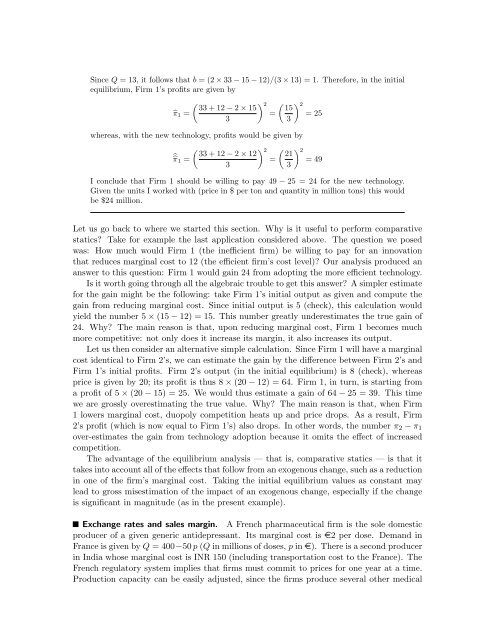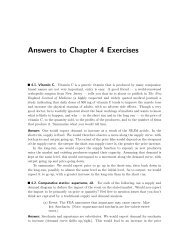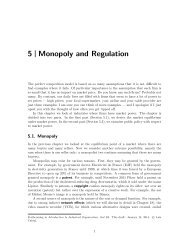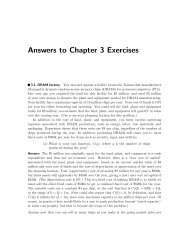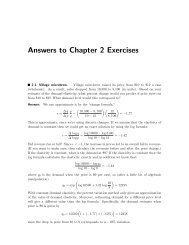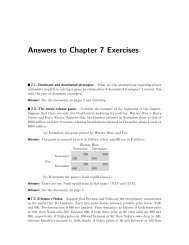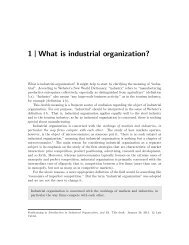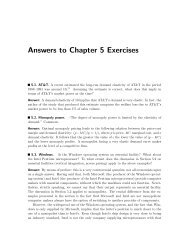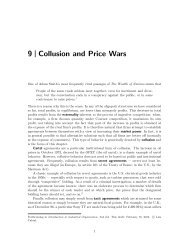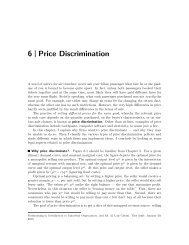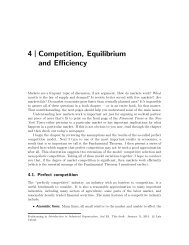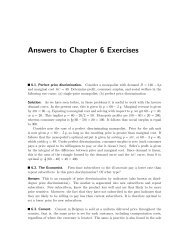8 Oligopoly - Luiscabral.net
8 Oligopoly - Luiscabral.net
8 Oligopoly - Luiscabral.net
You also want an ePaper? Increase the reach of your titles
YUMPU automatically turns print PDFs into web optimized ePapers that Google loves.
Since Q = 13, it follows that b = (2 × 33 − 15 − 12)/(3 × 13) = 1. Therefore, in the initial<br />
equilibrium, Firm 1’s profits are given by<br />
( ) 2 33 + 12 − 2 × 15<br />
̂π 1 =<br />
=<br />
3<br />
( ) 2 15<br />
= 25<br />
3<br />
whereas, with the new technology, profits would be given by<br />
( ) 2 ( ) 2 33 + 12 − 2 × 12 21<br />
̂π 1 =<br />
= = 49<br />
3<br />
3<br />
I conclude that Firm 1 should be willing to pay 49 − 25 = 24 for the new technology.<br />
Given the units I worked with (price in $ per ton and quantity in million tons) this would<br />
be $24 million.<br />
Let us go back to where we started this section. Why is it useful to perform comparative<br />
statics? Take for example the last application considered above. The question we posed<br />
was: How much would Firm 1 (the inefficient firm) be willing to pay for an innovation<br />
that reduces marginal cost to 12 (the efficient firm’s cost level)? Our analysis produced an<br />
answer to this question: Firm 1 would gain 24 from adopting the more efficient technology.<br />
Is it worth going through all the algebraic trouble to get this answer? A simpler estimate<br />
for the gain might be the following: take Firm 1’s initial output as given and compute the<br />
gain from reducing marginal cost. Since initial output is 5 (check), this calculation would<br />
yield the number 5 × (15 − 12) = 15. This number greatly underestimates the true gain of<br />
24. Why? The main reason is that, upon reducing marginal cost, Firm 1 becomes much<br />
more competitive: not only does it increase its margin, it also increases its output.<br />
Let us then consider an alternative simple calculation. Since Firm 1 will have a marginal<br />
cost identical to Firm 2’s, we can estimate the gain by the difference between Firm 2’s and<br />
Firm 1’s initial profits. Firm 2’s output (in the initial equilibrium) is 8 (check), whereas<br />
price is given by 20; its profit is thus 8 × (20 − 12) = 64. Firm 1, in turn, is starting from<br />
a profit of 5 × (20 − 15) = 25. We would thus estimate a gain of 64 − 25 = 39. This time<br />
we are grossly overestimating the true value. Why? The main reason is that, when Firm<br />
1 lowers marginal cost, duopoly competition heats up and price drops. As a result, Firm<br />
2’s profit (which is now equal to Firm 1’s) also drops. In other words, the number π 2 − π 1<br />
over-estimates the gain from technology adoption because it omits the effect of increased<br />
competition.<br />
The advantage of the equilibrium analysis — that is, comparative statics — is that it<br />
takes into account all of the effects that follow from an exogenous change, such as a reduction<br />
in one of the firm’s marginal cost. Taking the initial equilibrium values as constant may<br />
lead to gross misestimation of the impact of an exogenous change, especially if the change<br />
is significant in magnitude (as in the present example).<br />
Exchange rates and sales margin. A French pharmaceutical firm is the sole domestic<br />
producer of a given generic antidepressant. Its marginal cost is e2 per dose. Demand in<br />
France is given by Q = 400−50 p (Q in millions of doses, p in e). There is a second producer<br />
in India whose marginal cost is INR 150 (including transportation cost to the France). The<br />
French regulatory system implies that firms must commit to prices for one year at a time.<br />
Production capacity can be easily adjusted, since the firms produce several other medical


